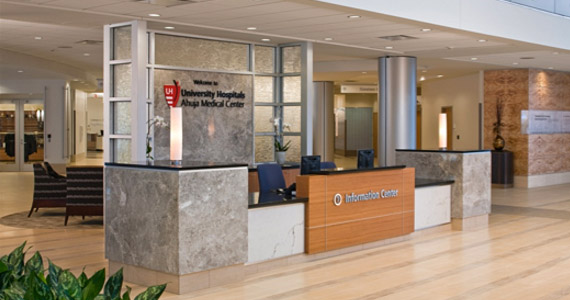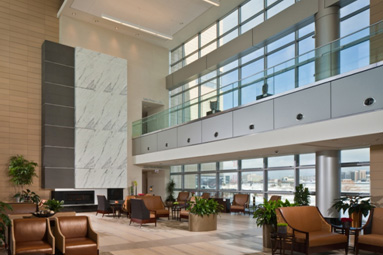

When people visit medical facilities, particularly those in urban areas where the exterior is often from another era, the interior environment can be a powerful indicator of quality: quality of care, quality of customer service and a quality experience. A torrent of clues about the organization and the exemplary medical care being delivered are evident upon entering the facility: the arrival sequence, the main lobby, elevator core, connective corridors and dining and retail opportunities to name a few.
The design of the interior environment can positively affect the expectations of patients and their loved ones. To inspire confidence and reduce stress, the environment must be in-sync with an organization’s reputation, mission and core values. A well-conceived environment will positively influence employee service, attitudes and behaviors. Colors, textures, patterns, artwork and graphics must be carefully selected, well coordinated and integrated into the overall design to resonate with patients, families and staff.
“Everything Speaks”
The old expression, “You never get a second chance to make a good first impression” applies to healthcare facilities.
• What do patients see, and how do they feel about the facility when they arrive?
• Does the drop-off area convey “welcome?”
• Does the lobby intimidate, or does it lend an air of calm, capable confidence?
• Can patients clearly find their way?
• Are the corridors and walls clean and undamaged?
Consumer decisions are based on quality of medical care, cost, accessibility and quality of service. An aesthetically-pleasing facility is a key aspect of the perceived quality of care and impacts actual quality of care.
Cost Effective Design
Healthcare is a labor-intensive industry and much of that labor is both highly-skilled and highly-paid. Since 60-75% of hospital expenses are labor costs, a design which increases operational productivity and efficiency as well as reduces staffing needs can have a major impact on the bottom line.
Likewise, operations and maintenance costs over the typical 50-year life cycle of a hospital contribute up to 80% of the equation, so each thoughtful design facet can facilitate maintenance ease, efficiency and cost savings. Reduction of total life-cycle cost will have tremendous returns on a relatively modest up-front investment.
Ideally, a hospital’s interior environment should convey a compelling impression of caring, comfort and compassion. The commitment to patient well-being and safety should be inherent. Every hospital has the potential to be a place where, in addition to quality healthcare is provided, stress is relieved, refuge is provided, respect is reciprocated, competence is symbolized, way-finding is facilitated and families are treated as partners.






